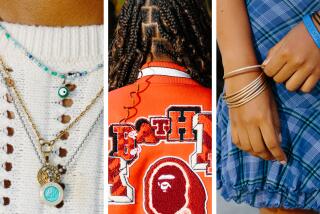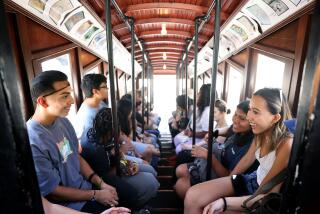Students Learn Hard Lessons on What It Means to Be Poor
The poverty was much worse than Lisa Tamburelli had ever imagined.
On a back street of downtown Los Angeles, where tall buildings were shrouded by a smoggy haze and the stench of rotten garbage and human urine filled the air, Tamburelli and several other students from St. Paul High School in Santa Fe Springs worked tirelessly, setting up a food line on the sidewalk before the lunch hour.
One by one, the poor walked out from behind shacks, cars and trash cans. Soon hundreds of hungry people, most dressed in rags, formed a straight line along the sidewalk and down around the corner. One by one, they came up to the food table, taking a peanut butter and jelly sandwich, a scoop of salad and a cup of cold water.
Tamburelli, 17, said she did not really know much about poverty. It was just a topic she had read and heard about. The poor were faceless--until now. By the end of the day, Tamburelli said she had learned hard lessons about the needy.
She is ready to go back to Skid Row, she said. It is a place where she feels she can make a small difference.
Every Monday students from St. Paul High School visit Skid Row in Los Angeles and Santa Ana to help members of the Catholic Worker, a Roman Catholic social service organization, feed the poor.
The St. Paul High School volunteer program was started 17 years ago by social justice teacher Daniel Jiru. Jiru said he started encouraging students to participate in the program when he realized that they had little concept of what it meant to be needy.
“I was teaching a contemporary issues class when I realized that the students were not connecting with what we were studying,” Jiru said. “Many live in a white ghetto up here. They’re middle-class kids and they just don’t see it (the poverty.)”
Jiru also started an annual March for Hunger. Every December students from the Catholic high school walk from the poorest parts of East Los Angeles through Hollywood and Beverly Hills to the beach at Santa Monica.
“They see the poorest of the poor to the playpens of the rich and famous,” Jiru said.
And when the march is over, the money the students raise is used to buy food and other supplies for the needy.
Jiru, who was recently named a Reader’s Digest Hero in Education for his efforts, estimates that several thousand students have participated in the Skid Row trips and the March for Hunger over the years. Last year, about 900 students signed up for the march. Nearly $16,000 was raised. This year’s march will be Dec. 10, Jiru said.
The lessons the students receive from working on Skid Row abound.
Several students who recently helped with the food line in downtown Los Angeles said they were shocked to see so many poor children, a memory they cannot erase from their minds.
“When I thought about the homeless, I always thought about adults,” Tamburelli said. “I never thought about whole families being out there.”
Mireya Medrano, 17, added: “When I go to bed at night, I think about the families out there, sleeping on the streets, sleeping in boxes, going without food. I want to do all I can to help them.”
The students’ day downtown begins at about 8 a.m. at the Catholic Worker headquarters, a historic, but run-down house not far from Skid Row. There they make sandwiches in an assembly-line fashion, say a prayer, and then pile into a van.
They usually set up the food line at Towne Avenue and 6th Street, where the homeless have come to expect them.
“They’re amazingly polite,” Medrano said of the people who frequent the food line. “They really appreciate what we are doing for them.”
Many of the people in the food line responded favorably to the young volunteers. Several smiled and said, “Thank you.”
“When they see young kids, it brightens their day,” Jiru said. “It shows them that the younger generation is a caring generation, they have not just chucked them out.”
Tamburelli said after she graduates in the spring, she plans to continue helping the poor.
More to Read
Sign up for Essential California
The most important California stories and recommendations in your inbox every morning.
You may occasionally receive promotional content from the Los Angeles Times.










